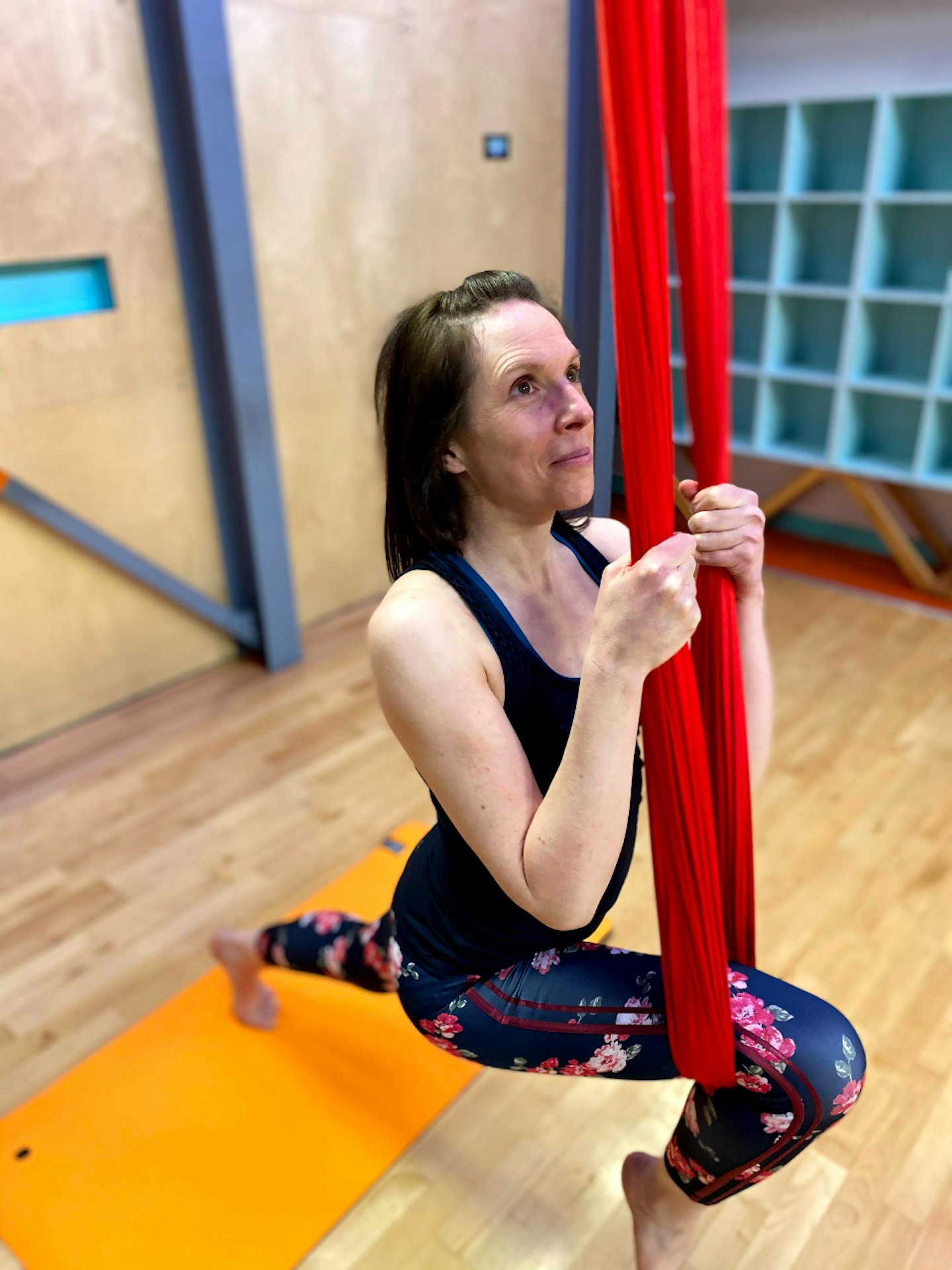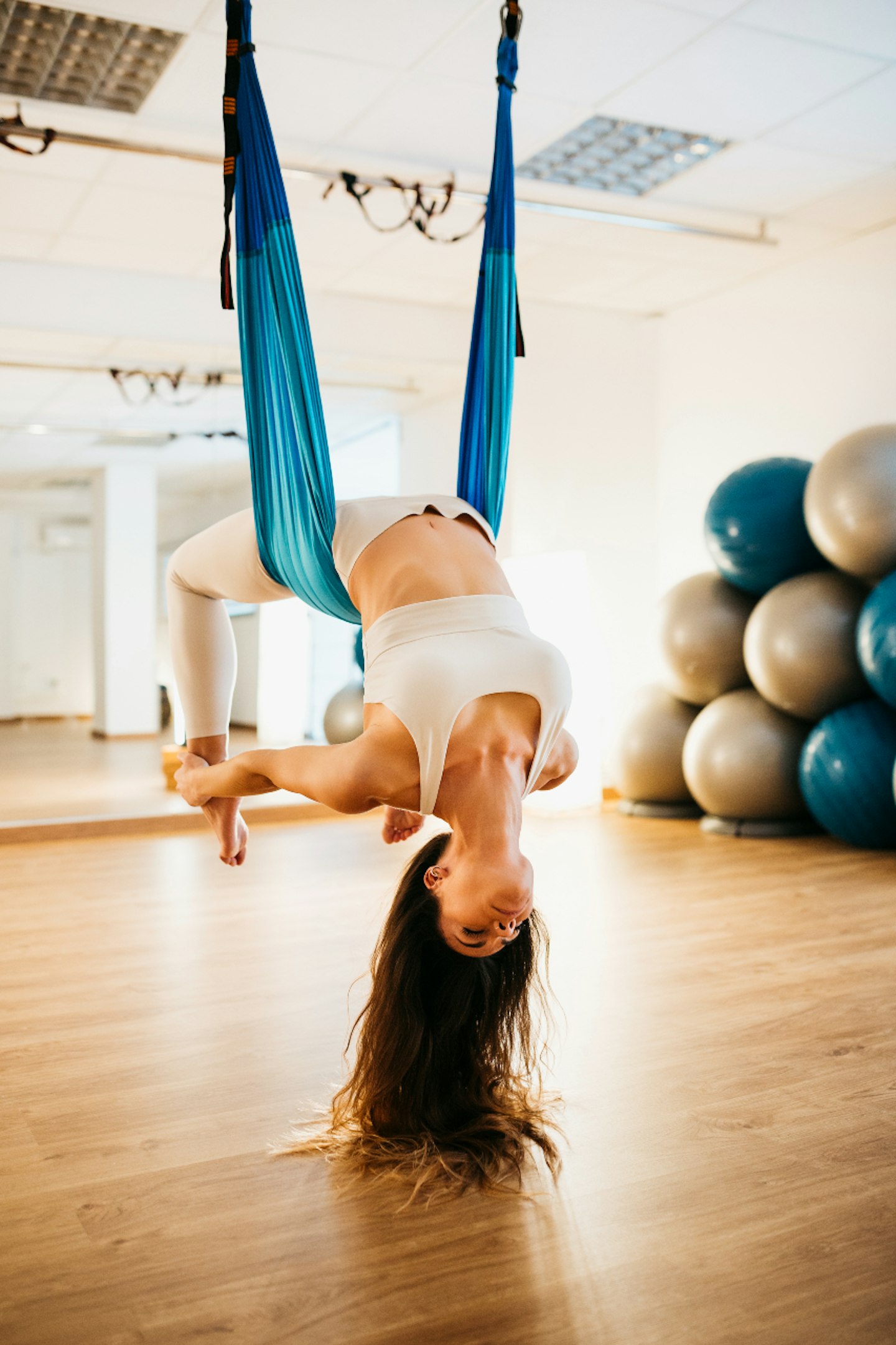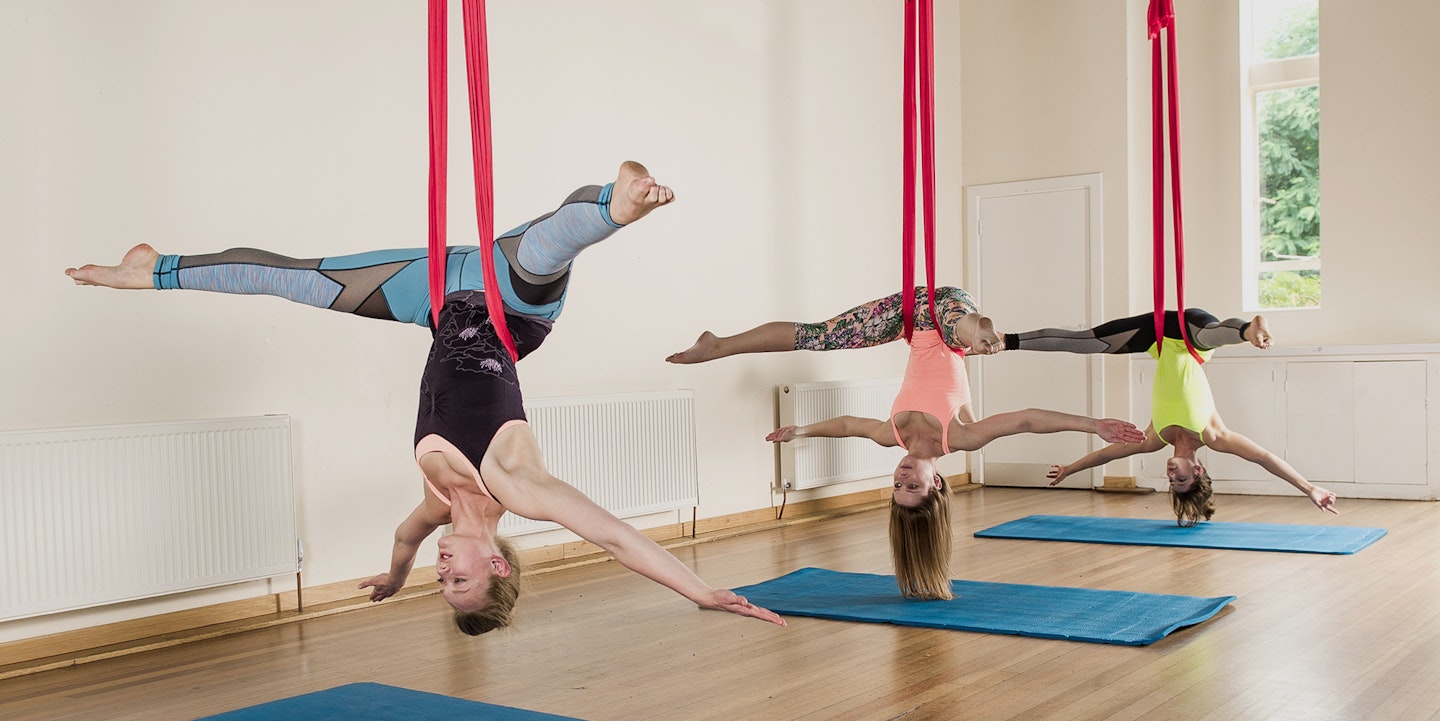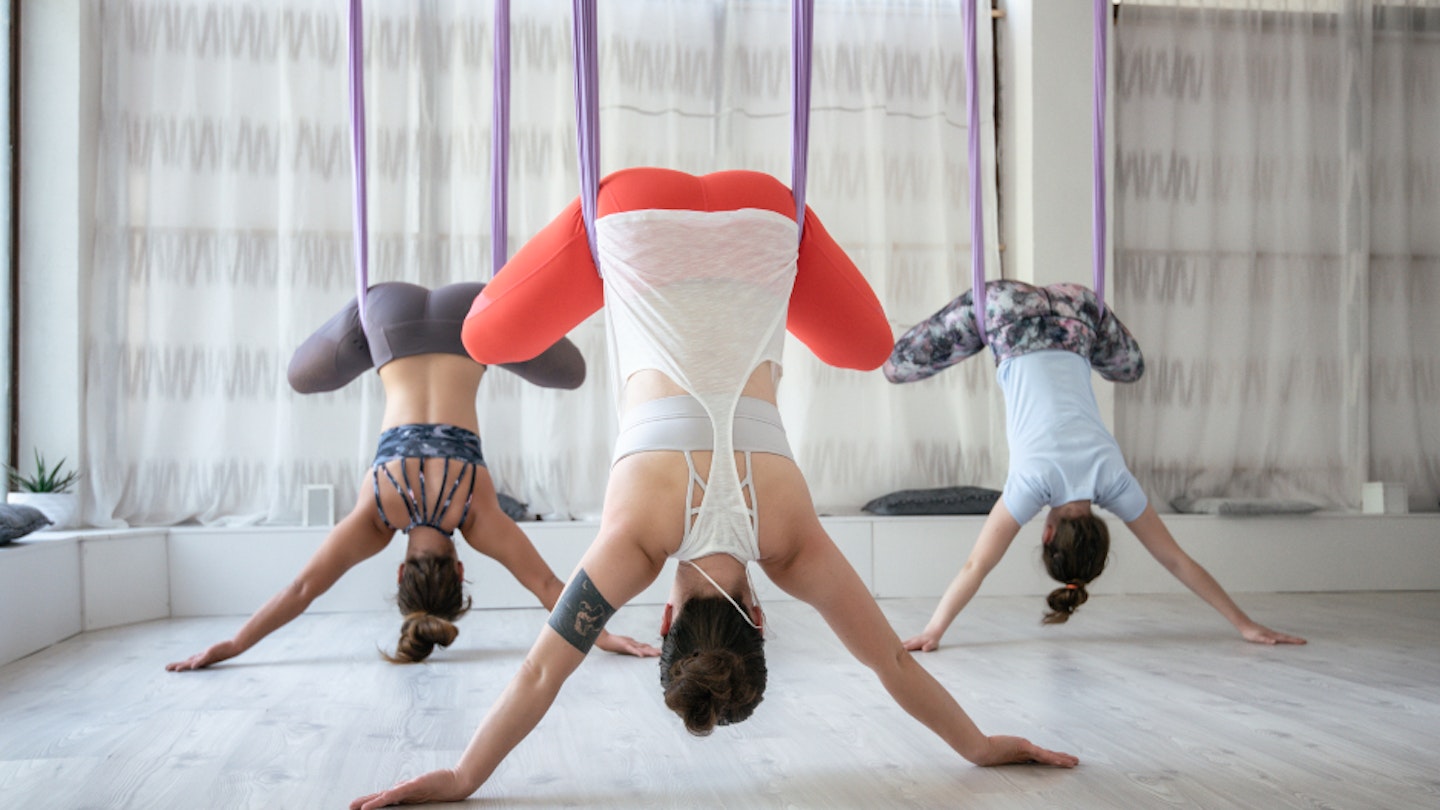Yoga is one of the most popular ways to keep fit, but if you fancy switching up your regular class or just want to give something new a go then why not try aerial yoga? Combining traditional yoga with aerial circus skills, aerial yoga is rapidly growing in popularity thanks to its many benefits for the body and mind.
If the idea of doing the downward dog in the air a bit daunting, there’s no need to worry if you want to take up aerial yoga as we’ve enlisted Edel Wigan, a qualified instructor and co-founder of aerial fitness school Flying Fantastic, to talk us through the basics of aerial yoga, its benefits and tips for beginners.

What is aerial yoga and how does it differ from traditional yoga?
“Aerial yoga is a really fun mixture of all that you would expect from a yoga class, but with a touch of aerial circus flair,” explains Edel. Rather than doing poses on a yoga mat on the floor, like in a traditional class, aerial yoga uses an aerial sling or hammock which helps to support some traditional yoga poses and takes others to the air.
Edel says, “Aerial yoga draws from the alignment and techniques of yoga using a yoga sling or hammock. By supporting your body weight on the aerial sling, it helps to access these postures and deep stretches in a more relaxed way.”
Using a yoga hammock to hang upside down relieves pressure on the body and decompresses the spine, which according to Edel, results in people often feeling taller or longer after an aerial yoga class. This also means that inversions like headstands and handstands are easier to achieve earlier on as you are supported by the hammock.
What are the benefits of aerial yoga?
There are "so many" benefits - both physical and mental - to aerial yoga, according to Edel. They include:
-
Total body workout - Due to the nature of aerial yoga movements almost all the body parts are forced to move and stretch. Muscles are toned and redefined, and joints are regenerated and strengthened due to these movements.
-
Improves flexibility - Aerial yoga helps you to move more freely, with less effort, by counteracting gravity. Suspension in the air releases tension on the bones and muscles, increasing flexibility and deepening your practice. Suspended yoga strengthens core muscles and increases spinal and shoulder flexibility.
-
Helps back problems - It gives you the chance to hang freely, allowing your spine to lengthen. With less strain on your back while doing the exercises, it eases tension in the spinal cord and hip joint helping you feel better.
-
Relieves stress - Just like almost any other workout, aerial yoga helps rebuild your emotional system because it clears the mind and relieves stress due to its meditative state. It also helps you combat stress throughout the day and increases your creativity, which leads you to develop your own artistic skills.
-
Increases strength - Aerial yoga improves strength and flexibility, which carries over into other daily activities. The core workout is a beneficial cross-training, for example; it helps runners increase stamina and be able recover faster.
-
Improves mood - Another key benefit of doing aerial yoga is that it gets your adrenaline going while going against gravity. It also releases “happy” hormones like serotonin, endorphins, oxytocin.
-
Improves balance - While going against gravity can be exciting, aerial yoga also helps with balance and stability in daily activities. Balance is a key component in daily activities and aerial yoga helps maintain a good balance both inside and out.
-
Aids digestion - The different types of stretches and movements help improve the digestive system, helping in healing various digestion-related issues, including constipation and indigestion.
-
Improves circulation - Aerial yoga improves the circulation of blood, thus combating aging and its symptoms. Aerial yoga also helps detoxify the circulatory and lymphatic systems, which lowers the onset of various cardiovascular issues.
-
Improves memory - Aerial yoga fortifies your neural connections, thereby, rendering better memory power. In a way, practicing aerial yoga can make you smarter!

Is there anyone who shouldn't do aerial yoga?
While aerial yoga is suitable for most people, there are medical conditions which might prevent some getting involved. Edel advises to check in with your doctor if you're unsure or have any concerns.
Can you do aerial yoga at home? What equipment is needed?
It is possible to do aerial yoga at home, as long as you have the right equipment. Edel recommends buying a rig from a certified circus equipment company and only hanging equipment that has been tested by an engineer and set up by a professional, as it can damage your ceiling and be unsafe. Doing aerial yoga at home is also only suggested for those who are well experienced and have had done a substantial amount of classes with a qualified instructor, as it can be dangerous if done wrong.
You might also want to invest in yoga socks to help you balance and prevent you from sliding all over the place while you're trying to master your pose.
What are the most common aerial yoga poses and their benefits?
The best known aerial yoga pose is probably the upside down straddle. It’s famed for its benefits as Edel explains, “Getting your head above your heart is so beneficial - and it's a well known fact that when you hang upside down, all the bad thoughts fall out.”

Another common pose is the supported pigeon pose, which involves one leg bent on the floor and the other supported in the sling. This pose helps open up the hip flexors.

What are the best tips for beginners?
Edel offers the following top tips for beginners:
-
Wear a t-shirt that wont end up over your head when you turn upside down.
-
Please eat before class. People worry about eating and turning upside down, but it is important to have something in your stomach, even if its just a banana, to avoid nausea. Motion sickness does happen sometimes if you’re in the hammock too long. Please tell your instructor straight away if this happens so they can bring you back to the floor. Don't suffer in silence.
-
Trust the hammock. As long as you have followed all the instructions and have an attentive teacher, the hammock will support you in moves you never thought possible.
-
Bring water for during and after the session.
-
Jewellery is a big no no in class as it can get caught either on you or in the fabric and damage it.
-
Don't wear thin leggings as no one wants to be showing off their pants in an upside down star shape!
Most of all, the best advice that Edel can offer is to give it a go and get stuck in. She says, "It's so much fun. People often talk about how they haven't hung upside down since childhood and about how amazing it is to do it again. I didn't hang upside down much as a kid, I was definitely late to that party, so I suppose Im just making up for lost time!
"The absolute beauty of aerial yoga is that, depending on the teacher or style you choose, it can be a very relaxing, meditative experience, or a hard core fitness class to rival any TRX class - and everything in between."
